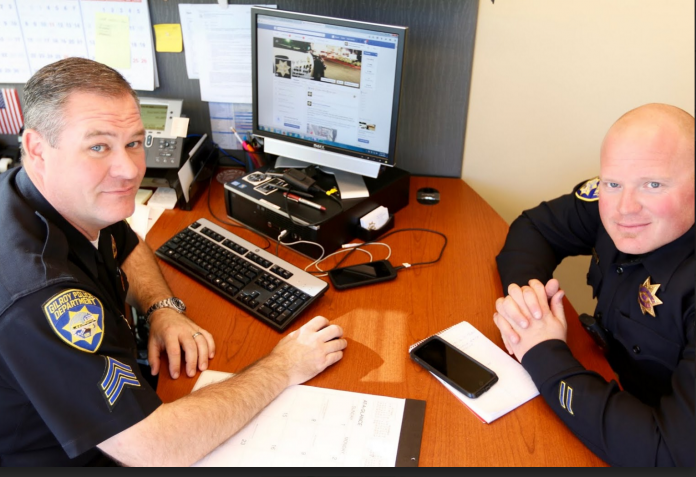In the old days, Gilroy Police Officer Mike Tarasco would have spent his days walking a beat, talking to people on the street and hunting for criminals as one of 65 officers patrolling a city of 53,000.
Today, he uses a different kind of network—specifically, the Gilroy Police Department’s Facebook page—to get citizens using social media to help track down bad guys.
While some police agencies use Facebook as a bulletin board to announce their latest programs and accomplishments, the Gilroy Police Department uses it as a tool in its crime-fighting arsenal. The results, they say, have been fantastic. In the first half of the year, Facebook has helped them net 27 criminal suspects, in many instances just minutes after police post a message.
Part of the reason for their success, say Tarasco and his supervisor, Sgt. Royce Heath, is the colloquial way they engage the public.
Like this post, asking people to report criminals:
“If you or someone you know has a pesky, shady, WANTED individual floating around the house and would like assistance with apprehending them, the Gilroy Police Department Anti-Crime-Team (ACT) would like to extend its assistance. Feel free to confidentially message GPD with any information pertaining to a known wanted person. Operators are standing by.”
It’s got an edge to it that more formal agencies might avoid.
Some of it comes from Tarasco’s age—33—and living in the Internet age. Some of it is because most of the day he’s a school resources officer surrounded by high school students.
“You have to keep it professional, but you have to keep it fun,” says Tarasco, who has been with the department since he was hired at 21. “You have to keep it a little bit young, too.”
Tarasco and Heath say they try to be engaged, to respond to comments on the page as soon as possible and filter out racism or hate speech. But that doesn’t mean they don’t share some humor or come off as the straight men to choruses of commenters.
Many of the photographs come from security cameras at retail establishments that capture suspected shoplifters. After the department posted a picture of a man seen stealing tools from Lowe’s on Nov. 7, some 32 commenters had a field day:
“Find him at the swap meets. That’s where he’ll be unloading the stuff. Go get him!” wrote Joanne Joye-Francesconi.
“He must have known the rain was coming. He is wearing ‘floods,’” added Chris Martinez.
And then, there’s this one from a theft case:
“These three stole a bunch of groceries and booze from the Gilroy Safeway on the evening of 10/15/15. With these pictures I’m sure it’s only a matter of time before we identify them. Thank you to our followers for your continuous help and support! #surrenderyourselves”
The initiative has critics as well. “I still don’t agree with our pd being used as loss prevention. They have bigger fish to fry,” commented a Raiders fan who identifies himself as Gilroy resident Paul Garcia.
Before social media, Tarasco says, police departments would get a photo of a suspect and pass it around to other agencies looking for them. Now, the photo can go up instantly, not just to surrounding police but to the department’s 6,942 Facebook friends, who can also circulate it to their friends—putting it on “blast,” says Tarasco. The page started two years ago with only a couple of hundred friends, and it’s still growing, they say.
Most tips to the department still come from phone calls, often spurred by the Facebook page. Some people fear they will lose anonymity by sending a message to police via Facebook.
“We attempt to interact with the public as people,” said Heath. “We’re not just getting public support, but we’re solving crimes. That’s just huge. In the past, a lot of these cases would be filed, with pictures and that would be the last time they were addressed.”
Putting suspects’ faces on Facebook may stop them from committing crimes in Gilroy, added Tarasco.
“It might just deter them. They think, I don’t want to be put on Facebook. It would embarrass them and they could lose their job. It’s not worth it.”
They credit Police Chief Denise Turner with having the vision to pursue social media as a crime-fighting tool and a city government that supports her.
As anyone who has spent time on Facebook knows, the social network sucks up time. It puts the officers on call all day and all night, although they are formally allotted about four hours a week to work on it. They end up working during their off hours.
They also use sites such as Twitter and Next Door, but Facebook, they say, gives them the most space to make their case. Twitter’s 140-characters has them handcuffed and Next Door only alerts neighbors who are signed up to it, so it cannot really go viral.
Both say that working a beat on social media may be a full time job in the future, especially with the quick results it’s bringing in solving crimes now.
“We’re catching people’s eye and getting them engaged,” says Heath. “They are feeling like they are being a part of the solution. I don’t think that’s what Mark Zuckerberg had in mind when he invented it, but it really works.”















